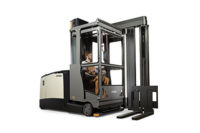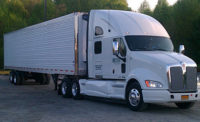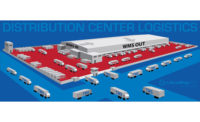Today’s lift trucks and racking solutions come equipped with advanced technologies to keep up with the ever-changing demands of cold food processors. Here’s some insight as to how forklifts measure up in the cold food industry.
Maximizing space
When it comes to racking, storage density, selectivity of date-sensitive product and allowance for first-in, first-out rotation are key features, says Perry Ardito, general manager, warehouse products for Mitsubishi Caterpillar Forklift America (MCFA), a Houston, Texas-based distributor of Jungheinrich products.
“We are seeing these buildings using racking going much taller to lessen some of the costs to build and reduce the cost per pallet stored, as it is typically less expensive to build up vs. out,” Ardito says.
That’s why Jungheinrich developed a new technology that allows operators to “snap” the lifting option on their reach trucks to a pre-determined rack height, which stops the forks for proper placement or picking of pallets in a rack location.
“Rack beam heights are programmed in four zones (A, B, C and D), then 5-rack beam heights (1, 2, 3, 4 and 5),” says Steve Rogers, Jungheinrich senior product marketing consultant. “For example, operator will select Zone B, pull back on the control handle, then as he approaches the desired beam level, will push the handle forward a little bit (to slow the lift speed), then pull completely back. The forks will then automatically stop within inches just above the beam level depending if loaded or empty. Then, when the operator lowers the forks, the forks will lower near perfectly to allow fork extraction from/insertion of the pallet.”
MCFA also introduced the new Jungheinrich ETR 230-235 series of pantograph reach trucks, which are 3,000- to 3,500-pound capacity single reach models that feature advanced AC technology, a color operator display panel with battery discharge indicator, drive wheel 360-degree travel direction and programmable performance levels and a tilting mast that enables the unit to be loaded into various enclosed van trailers or ocean containers in an upright, wheels-on-the-floor position. It also combines on-board electric controllers, AC electrical motor technology and an exclusive servicing software system to minimize energy consumption.
When operators start putting items away at 40 feet in the air, obviously issues with how they can interface and see may occur, says Brandon Hodge, sales manager for Associated, a Chicago-based sales and service center for The Raymond Corp., Greene, N.Y.
As a result, Raymond developed the Model 9800 Swing-Reach truck, engineered to triple pallet capacity in existing square footage by reaching heights of 40-50 feet in very narrow aisle storage facilities. Its advanced lift system with regenerative lowering is said to reduce energy use by 40% per lift cycle. And, a unique articulated steering system increases maneuverability and frees up space for additional storage locations.
“Customers want to go higher, they want to go faster and they want to run longer, and so all of that has been the driver into the equipment that Raymond is providing for the marketplace,” Hodge says.
Batteries make for longer “shelf” life
Batteries are often overlooked when considering use in a cold environment. For instance, at 30°F, industrial batteries operate at 75% efficiency, at 10°F they operate at 56% efficiency, at 0°F they operate at 45% efficiency and at -20°F they operate at 20% efficiency, says Jim Ripkey, president of Hy-Tek Material Handling Inc. Material Handling, Columbus, Ohio.
“The battery will operate warmer than its surroundings, but a truck should not be left idle or stored in a cold environment to promote better battery efficiency,” he says. “It is important to charge the battery outside of the cold environment.”
Lift trucks can be equipped with features to help combat the challenges created by cold environments, Ripkey says.
“In fact, because of the frequent temperature change, a truck that moves frequently from an ambient temperature to a cold temperature is the ideal candidate for cold modification due to the sweating or condensation created by the temperature changes. It is recommended that the truck remains in the cooler or freezer throughout the shift. When the truck is removed, it should be allowed to dry out completely. If the truck is left in the cold environment, it should be parked on rubber mats to prevent flat spots on the wheels,” he adds.
Increased operator comfort
Lift truck manufacturers continue to churn out new innovations that improve operators’ comfort and efficiency.
For example, Jungheinrich enhanced its AC technology, allowing for extended shifts in even the harshest of environments, and offers a range of lift trucks that include enclosed heated cabs, allowing operators to work while seated.
“In these applications whereby an operator is required to spend up to a third of their time outside of the freezer to warm up, with these cabs they can work full shifts, moving more product and reducing those costs per pallet,” says Ardito. “The fully enclosed cabin with heater allows operators to go into a freezer wearing regular clothes (no bulky outfit or gloves). This increases material handling productivity since the operator can stay in the freezer longer than a person [just] wearing insulated clothing.”
Increased productivity demands in an already challenging environment also continue to drive product enhancements focused on operator comfort at Hyster Co., Greenville, N.C. That’s why the Hyster narrow aisle N30-40ZRS2/ZDRS2 and N30-45ZR2/ZDR2 series of single and double-reach trucks feature a larger operator compartment with no pedal to step over for smooth ingress and egress.
“Ergonomics in cold storage have been considered throughout Hyster’s design process to produce options from heated handles and floor mats to a fully integrated, factory-installed operator cab,” says Matt Barrow, product manager. “Operators often dressed in bulky clothing can have trouble entering, exiting and/or maneuvering within the operator compartment.”
Meanwhile, Toyota Material Handling U.S.A. Inc., Irvine, Calif., released 8-Series electric stand-up rider counterbalance forklifts. Available in 3,000- to 4,000-pound lifting capacities, these forklifts provide technological and ergonomic enhancements that improve performance and increase operator comfort, says Cesar Jimenez, national manager of product planning and training. The 8-Series electric stand-up rider features Toyota’s AC technology, resulting in better travel speeds, consistency in performance throughout the battery charge and reduced maintenance costs.
“The forklifts are ideal for use in general warehouse and storage operations needing a dock-to-stock solution for multi-tasking functions and constant on and off for loading and unloading,” adds Jimenez.
Crown Equipment Corp., New Bremen, Ohio, introduced Crown TSP 7000 and 6500 Series turret trucks. Featuring an operator-centric design, the truck’s operator compartment is affixed with a cold storage cabin that can withstand temperatures as low as -40°F.
Harness the data
As forklifts evolve to become one of the most connected pieces of equipment in the warehouse, it’s important for companies to harness the data the truck provides and use the data to improve efficiency.
“There’s a lot of speculation about new technologies, but before anything can be properly implemented, it’s important for facilities to have actionable information to make decisions,” says Tim Forlow, senior marketing product manager for Crown Equipment.
To meet this trend, Crown developed InfoLink, a wireless operator and fleet management solution that puts the power of accurate, up-to-date business metrics right at operators’ fingertips. InfoLink lets operators manage equipment access and operator certification, streamline pre-shift inspections, document the process with digital records, receive incident alerts and impact details, identify problem spots to reduce damage, promote safe truck operation, record and compare truck activity by operator, analyze productivity across facilities, departments and shifts and ensure optimal use of equipment for the task.
In addition, Crown provides Access 1 2 3, a comprehensive system control that enables safe, reliable lift truck performance and diagnostics across the full line of Crown trucks.
Meeting future demands
The cold food industry continues to evolve to meet manufacturing and distributing needs. With an emphasis placed on the environment and the passage of strict emissions standards, many cold food processors are converting from using products powered by internal combustion engines to those powered by industrial batteries, Jimenez says.
“There is great interest in new technologies, such as fuel cell, lithium-ion and hybrid-powered vehicles,” he says.
Others have expressed interest in fuel cell technology, such as fuel cell stacks, which provide alternative energy solutions to the lift truck market, according to Mick McCormick, vice president of warehouse solutions at Hyster.
“This power source opens up possibilities for increased productivity and run time that was previously unattainable with batteries, making this even more attractive to the cold storage industry,” he says. “Furthermore, food distribution is one of the best sectors for fuel cell applications because it trends toward the high-throughput, multi-shift operations that benefit most from this increased productivity. Additionally, fuel cells are a great solution for cold storage because they can offer optimized performance in low and sub-freezing temperatures.”
Customers are also in search of a communication tool on the truck that makes certain an authorized driver is on the truck, the safety checklist is done and any impacts are detected and management, says Michael Petinge, president of Abel Womack Inc., a Lawrence, Mass., representative of Raymond Corp.
“It also allows to track metrics for operators and equipment such as hours lifting, hours lifting with a load, travel time, etc.,” he explains. “But, more importantly is the ability for this information to be tied into the customer’s warehouse management system as well as the customer’s labor management system. This type of technology fills the gaps nicely by gathering information that complements the other systems. At the end of the day, the customer has full visibility of what went on within the four walls of their facility.”
Likewise, operator-less vehicles that use lasers and vision systems will also continue to grow, says Petinge.
“Obviously not having an operator working is important, but what better place than a refrigerator or freezer, which is pretty cold,” he says.
Whether they’re runninglonger hours between charges, featuring advanced technology or are built to maximize space and withstand harsh environments, today’s lift trucks and racking solutions are equipped to keep up with the ever-changing demands of cold food processors.











